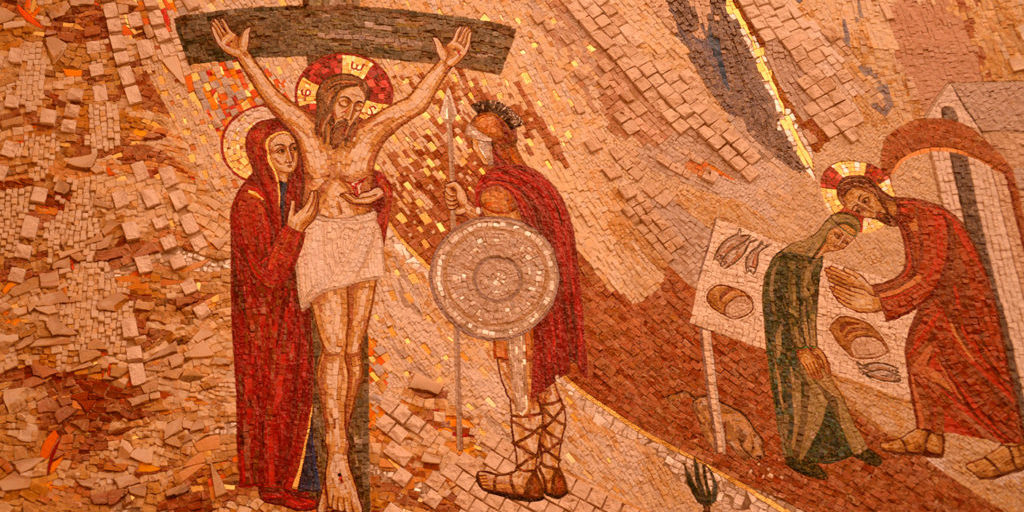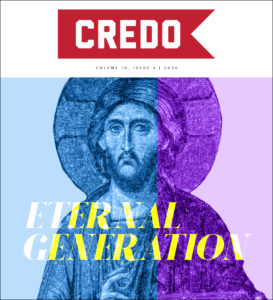
The Radiance of the Father: The Nicene Creed and the Incarnation
T he new issue of Credo Magazine focuses on the eternal generation of the Son. The following is an excerpt from one of the issue’s featured articles by Madison N. Pierce. Pierce is Assistant Professor of New Testament at Trinity Evangelical Divinity School and co-editor of Muted Voices of the New Testament (with Katherine M. Hockey and Francis Watson, 2017).
he new issue of Credo Magazine focuses on the eternal generation of the Son. The following is an excerpt from one of the issue’s featured articles by Madison N. Pierce. Pierce is Assistant Professor of New Testament at Trinity Evangelical Divinity School and co-editor of Muted Voices of the New Testament (with Katherine M. Hockey and Francis Watson, 2017).
I spent the earliest years of my faith holding to the mantra “no creed but the Bible.” I read books about sola Scriptura, and I trusted in my (and my pastors’) abilities to approach the Bible and walk away with the right interpretation through the illumination of the Spirit. We read earnestly, and so God would reward us… At this stage in my faith, I truly believed that my pastors were always right.
Years later as I approached my undergraduate degree, I had a sneaking suspicion that my pastors might not be right about everything, but I worried this was due to my own rebellion. Suddenly, I learned that my professors had different opinions from my pastors, and even different opinions from one another. Each of these godly people also seemed to read earnestly, so who had God rewarded with the right interpretation? Who could I trust? Who was faithful? By the end of my program, I had a fuller understanding. I could distinguish between an essential component of the faith and a distinctive of my denomination. Today I define the essential components of the faith “once for all entrusted to the saints” (Jude 3) as the teachings of the Creeds and Councils. They have been preserved for us by the grace of God, and they provide global unity for all who profess faith in Christ.
The Creed and the Christ
The Creeds can offer this because they are representative of early interpretations of scripture from the first centuries of Christianity. The Creeds do not cite single texts of Scripture, but they seek to synthesize the whole counsel of God. Those who have departed from their teachings and attempted to operate independent of their authority have often failed to consider the relationship among texts of Scripture (e.g., subordinationist readings of 1 Cor. 11:3), sometimes falling prey to egregious proof-texting.
The true danger of “no creed but the Bible” is when that phrase really means something like “no interpretation but my own.” Our New Testament writers were not ashamed to build upon traditions, and we shouldn’t be either. Click To Tweet Turning to our section of the Nicene Creed, we shall see that the Creed is wholly dependent on Scripture, drawing its language and its logic from the Word of God. The true danger of “no creed but the Bible” is when that phrase really means something like “no interpretation but my own.” Our New Testament writers were not ashamed to build upon traditions, and we shouldn’t be either.
For instance, in 1 Corinthians 15:3–8, Paul summarizes what he “received” and “passed on”—“that Christ died for our sins according to the Scriptures, that he was buried, that he was raised on the third day according to the Scriptures, and that he appeared [to many]…” Paul uses this standard teaching in two ways. First, he “flexes” a bit and reminds the Corinthians that he is one of the apostles who by God’s grace saw the risen Christ, and second, and more importantly for our purposes, he uses this as a starting point for his teaching about bodily resurrection. Most think that Paul is drawing upon a standard early Christian formula here. In other words, Paul was not the first (or only) to summarize the saving work of Jesus in this way. Paul appeals to tradition.
The tradition that he recounts here is in the form of a narrative, yet Paul (or his precursor) has woven in the theological significance. For example, Christ “died for our sins” and “was raised on the third day”—both “in accordance with the Scriptures.” Those Scriptures—most likely Isaiah 53 and Psalm 16, respectively—imply that Jesus is both Servant and Messiah. From here, the associations and allusions multiply.
Continually, we see that the shape of Jesus’ life, as portrayed by the Gospels, reflects broader theological truths about who he is. I offer this reminder as we turn to this section of the Creed that explicitly offers a narrative summary of the life of Jesus because his life and its significance are indistinguishable. In fact, this section of the Creed builds upon the prior declaration that Jesus is the one Lord, who is the true God and Light begotten from the Father. To say that he is “God from God” is to say that, while he was sent, he is of the same kind as the Sender.
The Word communicates on behalf of God, sharing his message to his people, but he also in a sense “communicates” God—who he is. Click To Tweet Thus, to be sent is not necessarily to be subordinate. Granted, the Son is not the Father’s first emissary, prophet, or anointed one who speaks on his behalf; God spoke to our ancestors through a number of mediums (Heb. 1:1), and the message they communicated on his behalf was true and good. But their message was limited because the message they offered was mediated. They stood in the image of God, but were not the image of the invisible God themselves (Col. 1:15). The Son is the “radiance of his glory” (Heb. 1:3) or the light that emanates from him. Although a prophet or angel of the Lord might speak for God in such a way that their voices become united, the prophet and the angel always remain a separate entity. This is not so with the Son; they are united in being and will.
In his Prologue, John tells us that, “no one has seen God at any time,” but “the only Son, who is God, being in closest relationship with the Father, has made him known” (Jn. 1:18). The image of the Word offers the best explanation of how the Father is “made known.” The Word communicates on behalf of God, sharing his message to his people, but he also in a sense “communicates” God—who he is. This is possible because he is the Light of the World who is from Light. Of equal glory, even as he dwells in our midst. He is the same yesterday, today, and forever (Heb. 13:8).
**Read the remainder of Madison N. Pierce’s article in the latest issue of Credo Magazine.

